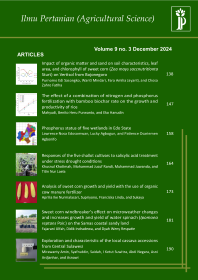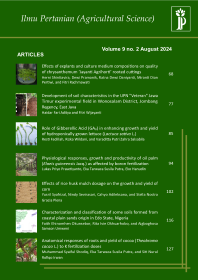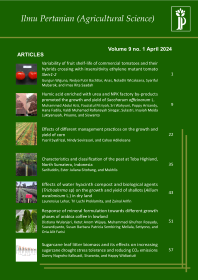Physiological Characters and Yield of Tea Shoots at Some Age of Production Pruning and Altitude
Retno Muningsih, Didik Indradewa, dan Endang Sulistyaningsih(1*)
(1) Fakultas Pertanian UGM Yogyakarta
(*) Corresponding Author
Abstract
ABSTRACT
Altitude in the tea plantation effect physiological processes of the tea plants. That will effect pruning time of tea plant. Therefore, this research is carried out to find: 1) Physiological process of tea plant grow in different ages of pruning and altitudes, 2) Optimum age of pruning at differentaltitude. The research was carried out in tea plantation in Inti PT Pagilaran Batang from July to November 2010. The research was conducted in Oversite design using 2 factor, hight place of plantation area (altitude) i.e 700-900 m asl (above sea level), 900-1100 m asl, 1100-1350 m asl and age of prune i.e 1-year after pruning, 2-years after pruning, 3-years after pruning and 4-years after pruning. All the combination treatment was replicated in 3 blocks. The observation were done on several variable of physiologi, growth and yield.All data were analyzed by variant analysis of oversite (multilocation) levels of 5%, followed by Duncant multiple range test level of 5% if there was significantly different in varian analysis.The results showed that at an The 3-years after pruning tea plants showed the lowest characters in fresh and dry shoot weight. Its pointed out bynumber of accumulative pecco shootthan 1, 2 and 4-years after pruning. Then in altitude of 900-1100 m asl and 1100-1350 m asl the 3-years after pruningthe tea plants showed the higher characters in fresh and dry shoot weight.Its pointed out by number of accumulative peccoshootthan the age of 1, 2 and 4-years after pruning.Decline in crop production occurs at the age of 4-years after pruning, marked by number of accumulative pecco shoots, weight per pecco shoot and length of internodia is lower.
Key words: tea, pruning, altitude, ecophysiology of tea
Full Text:
PDFReferences
DAFTAR PUSTAKA
Carr, M. K. and Stephens, W., 1992. Climate, weather and The Yield of Tea. In Tea: Cultivaation to Consumtion. 87-135, London: Champman and Hall.
Decosta, W.A.J.M., D. M.S. Navaratnes and Anandacoomaraswamy. 2009. Physiological basis of yield variation of tea (Camellia sinensis) during different years of the prunning cycle in the central highlands of Sri Langka. Exp. Agr. 45: 429-450
Gardner,F.P, R.B Pearce and R.L. Mitchel, 1991. Physiology of Crop Plants. Iowa State University Press Ames.
Suseno, H., 1977. Beberapa Aspek Fisiologis Pada Tanaman Teh. Warta balai penelitian teh dan kina gambung. Bandung. Vol. 3 No.4. p: 263-268
Wijeratne, M.W., 1994. Effect Climatic Factor on The Growth of Tea (Camellia sinensis L) in The Low Country Wet Zone of Sri Langka. PhD Thesis, Wye College, University of London.
Article Metrics
Refbacks
- There are currently no refbacks.
Ilmu Pertanian (Agricultural Science) ISSN 0126-4214 (print), ISSN 2527-7162 (online) is published by Faculty of Agriculture Universitas Gadjah Mada collaboration with Perhimpunan Sarjana Pertanian Indonesia (PISPI) and licensed under a Creative Commons Attribution-ShareAlike 4.0 International License.













